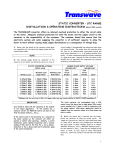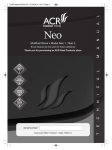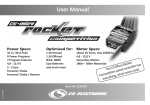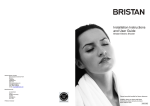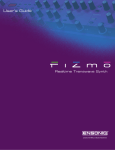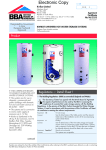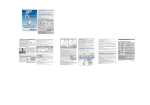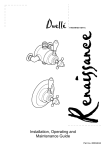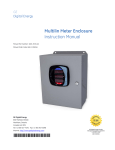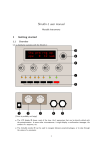Download rotary converter – rt range installation & operating instructions
Transcript
TRANSWAVE Sales, Service and Support Tel – 0121 7084522 Switchboard – 0121 7082811: Fax – 0121 7654054 E-mail: [email protected] www.powercapacitors.co.uk ROTARY CONVERTER – RT RANGE INSTALLATION & OPERATING INSTRUCTIONS Adequate overload protection for both the driven machinery and the supply circuit to the converter is the responsibility of the customer. The customer should also ensure that the electricity system and cable supplying the converter is of sufficient capacity to allow the motor to start without causing undue supply disturbances as a consequence of voltage drop. THE CUSTOMER MUST ENSURE THAT THE OUTPUT NEUTRAL FROM THE CONVERTER IS NOT CONNECTED TO THE ELECTRICITY PROVIDER’S SUPPLY NEUTRAL OR THE SUPPLY NEUTRAL FROM A GENERATOR. THE SINGLE PHASE SUPPLY NEUTRAL MUST BE KEPT ELECTRICALLY SEPARATE FROM THE CONVERTER OUTPUT NEUTRAL TO AVOID DAMAGING THE CONVERTER. 1) Ensure that the details on the converter rating plate are compatible with the electricity supply system and the required motor loads. 2) The incoming supply should be connected to the converter via an isolator and protection device (i.e. Fuse or Type C “motor rated” circuit breaker). Recommended fuse ratings and cable sizes are indicated below. The output from the converter takes the form of a three-phase neutral and earth socket (Notation: L1, L2, L3, and N). All earth connections should be securely connected to a good earth point. Removal of the socket will compromise any warranty offered by the manufacturers. ROTARY CONVERTER RATINGS CYCLIC LOAD Minimum Load No minimum No minimum No minimum No minimum No minimum No minimum No minimum No minimum Maximum Load Single Motor 3.00kW/04.0hp 4.00kW/05.5hp 5.50kW/07.5hp 7.50kW/10.0hp 11.0kW/15.0hp 15.0kW/20.0hp 15.0kW/20.0hp 18.5kW/25.0hp SINGLE PHASE SUPPLY VOLTAGE 220/240 VOLT Fuse Maximum Load Circuit Multi Motor Breaker Cable* 3.00kW/04.0hp 25A 4.0mm 4.00kW/05.5hp 25A 4.0mm 5.50kW/07.5hp 30A 4.0mm 7.50kW/10.0hp 40A 6.0mm 11.0kW/15.0hp 60A 10.0mm 15.0kW/20.0hp 80A 16.0mm 18.5kW/25.0hp 100A 25.0mm 22.0kW/30.0hp 120A 25.0mm *Minimum size for run of up to 20m. For longer cable runs see current edition of BS7671/AS300 amendment 2. 3) The RT converter incorporates a rotary transformer, which establishes the artificial threephase output from the converter when energised. 4) Before any machinery is connected to the output of the converter, switch the converter on by using the ‘ON’ button located on the converter. The converter will automatically attain its full operating speed within a few seconds. POWER CAPACITORS LIMITED 30 REDFERN ROAD TYSELEY BIRMINGHAM B11 2BH 1q BS EN ISO 9001 Certificate No. 8174 The initial surge required to start the motor is provided by the boost circuit of the converter. The “boost on” light indicates the circuit is energised. The circuit is controlled automatically from within the converter, switching on whenever a motor is starting against load and switching off once the motor has attained its full running speed. If the boost light does not go out within a few seconds the converter should be switched off to avoid the possibility of electrical damage. The reason for this condition should be checked and corrected before the converter is restarted. 5) Note that if voltages were checked at this point phase to phase readings would be similar to those experienced on a mains three-phase supply. Note that the voltages do not relate to earth as they would on a mains three-phase supply. Switch the converter off and connect driven machines to the converter output socket. Care should be taken with the connection of the machine to the output socket. If the machine has a contactor starter the 400/415v-control coil must be fed from the phases marked L1 and L2. If the control circuit is fed incorrectly (i.e. connected to the phase marked L3) the contactor could chatter when operating. Similarly, a control transformer and/or lighting transformer with a primary winding of 415v must be fed from the L1 and L2 phases. Connection to the L3 phase could lead to premature ageing of the control transformer. The RT converter can accommodate both a 415v control circuit (as above) and a single phase 240v control circuit provided the L1 phase is used in conjunction with the output Neutral. Multi-motor applications should be supplied from the converter output via a three-phase radial or similar. Note that the output neutral is for control circuit loads only. It should not be connected to any single-phase inductive or resistive loads. If the rotation of the driven machine motor is incorrect, ensure that the converter phases marked L1 and L2 are changed for 415-volt phase-phase control circuitry. For 240-volt phaseneutral control circuitry, ensure that the phase-neutral supply is maintained and the other two phases reversed. The motor starting current is limited to approximately three times the full load current of the motor. The starting characteristics of a three-phase motor supplied by a converter are similar in nature to Star/Delta starting on a three-phase system. Significant reductions in starting torque are experienced when compared with direct on line starting on a three-phase supply. For machinery supplied by a converter, direct-on-line starting is recommended. For machinery fitted with Star/Delta starters, the period in the star connection should be as short as possible to ensure a successful start. 6) An over-temperature sensor protects the converter. If the converter trips out on overtemperature, the output supply lamp will go off. The converter will not restart until it has sufficiently cooled. Checks should be carried out to ascertain why the converter has overheated, before restarting. NOTE - The output from a TRANSWAVE Converter cannot be compared directly to a mains threephase electricity supply. The TRANSWAVE Converter offers an artificial means by which a threephase motor (or motors) can be operated from a single-phase electricity supply. The TRANSWAVE Converter cannot be made to work equally on all motors, even though the horsepower, speed and voltage ratings are the same. Motors of differing manufacture and motors designed for differing applications vary considerably in their electrical characteristics. It is not always possible to make a universally applicable converter to operate a motor of given horsepower and rating. TRANSWAVE Converters are not designed for use in conjunction with continuous duty applications. © Power Capacitors Limited 05/2002



